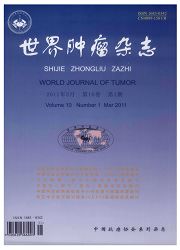

 中文摘要:
中文摘要:
目的 探讨p53蛋白表达在HPV16型感染相关的新疆维吾尔族妇女宫颈癌发生发展中的作用。方法 采用半巢式PCR和免疫组化技术检测79例新疆维吾尔族妇女宫颈癌组织中HPV16 DNA和p53蛋白表达情况,探讨其与宫颈癌发生的相关性。结果 在宫颈癌组织中,HPV16检出率为81.0%(64/79),高于对照组7.5%(3/40),二者存在显著性差异(x^2=58.328,P=0.000)。宫颈癌组中p53蛋白阳性率为68.4%(54/79),明显高于正常宫颈组织12.5%(5/40),二者在统计学上有显著性差异(x^2=33.140,P=0.000)。结论 高危型HPV E6介导的p53蛋白降解失活是宫颈癌发生的重要机制之一,但在部分HPV感染的宫颈癌组织中p53蛋白表达蓄积的现象提示宫颈癌的发生还涉及到其它多基因和多步骤的致癌机制。
 英文摘要:
英文摘要:
Objective To investigate the correlation between p53 protein expression and cervical carcinoma with HPV16 infection in Xinjiang Uigur women. Methods HPV16 DNA and P53 protein of 79 cases of cervical carcinoma were detected by semi-nested PCR and immunohistochemistry methods, respectively. Results HPV16 DNA was found in 64 of 79 (81.0%) in cervical carcinoma and in 3 of 40 (7.5%) in normal group. The positive rate of HPV16 was significantly higher in cervical carcinoma than that in normal group (x^2=58.328, P=0.000). The expression of p53 protein detected in 54 of 79 (68.4%) in cervical carcinoma was higher than in 5 of 40 (12.5%) in normal group (x^2=33.140, P=0.000). Conclusions Degradation and inactivation of P53 protein by high-risk HPV E6 may be an important mechanism in cervical carcinoma. But P53 protein could be accumulated in some HPV infective cases, this phenomenon suggests that the carcinogenesis of Uigur cervical carcinoma may involve in other events of multiple genetic abnormalities and multiple steps.
 同期刊论文项目
同期刊论文项目
 同项目期刊论文
同项目期刊论文
 期刊信息
期刊信息
